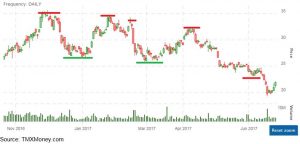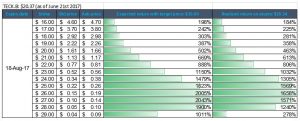Strike prices and GPS

One day I was driving home after work and I received a call from an old friend, Alex. We started talking about the kids and the wife but, eventually, we ended up talking about the markets. Alex has some knowledge of options, but there was one thing that he didn’t understand. He asked me, “How do you know which strike price to use?” It was a legitimate question. As a matter of fact, many investors I meet ask me the same thing: How do you select a strike price? So, I answered him with another question: “Alex, how do you use your GPS?” He told me to stop joking around, but I was serious, because selecting an option strike price is the same thing as using a GPS: you need to know where you are going, your destination. If not, there is no point to having a GPS, just like options. Now I will share with you what I told Alex that day about option strike prices and GPSs.
For simplicity’s sake, I will stick with a call option. For those of you who may be unfamiliar with options, a call option gives the owner the right (but not the obligation) to buy the underlying stock at a given price (called a strike price). This call option gives the holder the right to buy the stock at any time until the option expires.
When you turn on a GPS, you have to tell it where you want to go and then it will give you the optimal route. The same thing is true of options (this applies to calls and puts): you need to have an expected target price. An expected target price is what you think the share price could be in the future. If you are new to target prices, you can find them in analyst reports or by using the technical analysis tools provided by your online broker.
Let’s go back in time so I can show you an actual example using Teck Resources Limited (TECK.B). In the candlestick chart below, on a few occasions (between December 2016 and April 2017) the share price climbed up into the low-mid 30s and then pulled back.
On June 21, 2017, the stock closed at $20.37. If we assume that it will rally back to $30, we can express this view by purchasing a call option (expiring on August 18, 2017).

The expected target price of $30 is equivalent to the final destination that we enter into a GPS. Whether or not we get there is another story. As long as we have an expected target price, we can reverse-engineer the route in order to find the optimal strike price that will give us the greatest return.
Expected target price: $30
Return formula:
(Expected target price – Strike price – Price paid for the call option)
Price paid for the call option
Simply apply the return formula to all the strike prices on the call options expiring on August 18, 2017. The strike price that yields the greatest expected return (in this case, $27) will be the one to use for this trade.

On expiry of the options (on August 18, 2017), Teck Resources Limited had rallied to $29.34. Anyone who had bought the $27 call options for $0.14 could have made a 1,571% return. And if the stock didn’t go our way, the maximum loss would have been $0.14 (or $14 per option contract).
Until next time, and may the best trades be with you.
By: Richard Ho, CAIA, DMS, FCSI, senior manager equity derivatives
The information provided on this website, including financial and economic data, quotes and any analysis or interpretation thereof, is provided solely for information purposes and shall not be construed in any jurisdiction as providing any advice or recommendation with respect to the purchase or sale of any derivative instrument, underlying security or any other financial instrument or as providing legal, accounting, tax, financial or investment advice. Bourse de Montréal Inc. recommends that you consult your own advisors in accordance with your needs before making decision to take into account your particular investment objectives, financial situation and individual needs.
All references on this website to specifications, rules and obligations concerning a product are subject to the rules, policies and procedures of Bourse de Montréal Inc. and its clearinghouse, the Canadian Derivatives Clearing Corporation, which prevail over the content of this website. Although care has been taken in the preparation of the documents published on this website, Bourse de Montréal Inc. and/or its affiliates do not guarantee the accuracy or completeness of the information published on this website and reserve the right to amend or review, at any time and without prior notice, the content of these documents. Neither Bourse de Montréal Inc. nor any of its affiliates, directors, officers, employees or agents shall be liable for any damages, losses or costs incurred as a result of any errors or omissions on this website or of the use of or reliance upon any information appearing on this website.
BAX®, CADC®, CGB®, CGF®, CGZ®, LGB®, MX®, OBX®, OGB®, OIS-MX®, ONX®, SCF®, SXA®, SXB®, SXF®, SXH®, SXM®, SXO®, SXY®, and USX® are registered trademarks of the Bourse. OBW™, OBY™, OBZ™, SXK™, SXJ™, SXU™, SXV™, Montréal Exchange and the Montréal Exchange logo are trademarks of the Bourse. All other trademarks used are the property of their respective owners.
© 2024 Bourse de Montréal Inc. All Rights Reserved.
